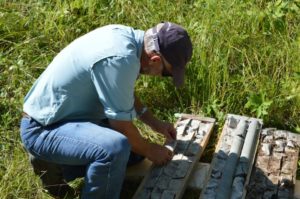Avalon up 43% on Ontario lithium PEA

Avalon geologist Chris Pederson organizes diamond drill core from the Separation Rapids Lithium Project near Kenora, northwestern Ontario. Source: Avalon Advanced Materials Inc.

By Peter Kennedy
Avalon Advanced Minerals Inc. [AVL-TSX; AVLNF-OTC] has completed an updated preliminary economic assessment (PEA) for its flagship Separation Rapids Lithium Project near Kenora, northwestern Ontario.
Avalon shares jumped 42.86% or $0.03 to 10 cents in early trading Wednesday August 22 on volume of 1.34 million shares traded. The 52-week range is 7 cents and 16 cents.
The company said the updated PEA reflects a simplified business model that focuses on initial production of lithium mineral concentrates, with potential for future expansion into production of the battery materials lithium carbonate and lithium hydroxide.
This smaller scale development model reduces capital expenditure requirements substantially from the original model completed in September 2016, while generating attractive returns and reducing overall business risk, the company said in a press release.
Avalon Advanced Materials is a Canadian mineral development company specializing in niche market metals and minerals with growing demand in new technology. The company has three advanced stage projects, all 100% owned, providing investors with exposure to lithium, tin, and indium as well as rare earth elements, tantalum, niobium and zirconium.
The company is currently focused on its Separation Rapids Lithium Project and its East Kemptville Tin-Indium project in Yarmouth, Nova Scotia.
The company said Separation Rapids has the potential to produce high purity lithium compounds for two distinct markets:
- An industrial mineral product for glass ceramics and lithium chemicals for energy stora;
- It also has the potential for several by-products, including feldspars, silica, rubidium, cesium, and tantalum
The Separation Rapids deposit is one of the largest “complex-type” lithium-cesium-tantalum pegmatite deposits in the world. It is unusual in its enrichment in the rare, high purity lithium mineral petalite. Petalite is the preferred mineral feedstock for certain glass-ceramic products for technical reasons, notably its low impurity levels.
Avalon said the petalite found at the Separation Rapids deposit could provide a high purity lithium chemical product at a relatively low cost to serve the needs of the lithium ion re-chargeable battery manufacturers.
The updated PEA utilizes a plant throughput rate of 475,000 tonnes per annum, compared with the 950,000 tonne per annum rate used in the 2016 PEA. This will result in a 20-year operating life, based on the present known mineral resources, with annual production of 71,500 tonnes of petalite concentrate, 11,800 tonnes of lepidolite concentrate (both for 18.5 year) and, starting in year six, 100,000 tonnes of feldspar (through to year 20).
The upfront capital expenditure requirement is $77.7 million with a further $13.7 million planned for the feldspar circuit in years five/six (or once payback of the initial capital is complete). Average annual revenue is forecast at $90 million, compared to average annual costs of $60 million, resulting in a pre-tax Net Present Value (at an 8% discount rate) of $156 million, and a Pre-Tax Internal Rate of Return of 27.15%
A positive Preliminary Economic Assessment (PEA) completed in September 2016, confirmed a technically viable process and positive economics for the recovery of a battery-grade lithium hydroxide product from Separation Rapids petalite.
Since it acquired the property in 1996, Avalon has spent approximately $10 million on exploration and development work. The September, 2016 PEA envisioned an open pit mine, potentially transitioning to underground mining in later years.
It assumed average annual production of 14,600 tonnes of lithium hydroxide for a minimum of 10 years and 100,000 tonnes per year of feldspar mineral concentrate.
Total capital expenditures were previously estimated at $514 million.
The Petalite and Lepidolite zones are estimated to contain 8.12 million tonnes in the measured and indicated category of 1.37% Li20, and 0.360% Rb20.
While much of the new demand and long-term growth prospects for lithium supply are centred on the rechargeable battery industry, Avalon said lithium remains a critical ingredient in many other applications such as glass and ceramics, which must now compete for supply with battery makers.
Petalite is the primary lithium mineral at Separation Rapids. Petalite production will be supplemented with the production of a second lithium mineral concentrate: lepidolite.
Lepidolite is a lithium mineral, which is in increasing demand for conversion to lithium carbonate.
Avalon already has a preliminary off-take agreement in place with Lepidico Ltd., an Australian company that is planning to develop a lithium carbonate demonstration production facility in Sudbury, Ontario.
As for Separation Rapids, the next step in the project’s development is to proceed with a short pilot program to finalize reagent recycling and water treatment processes, after which a comprehensive feasibility study will be completed. Avalon said it is planning to start the formal permitting process later this year, once sufficient engineering data and project financing are in place.
The company is also working with Hydro One to determine the optimal route to deliver clean hydroelectric power to the site from a nearby dam.
